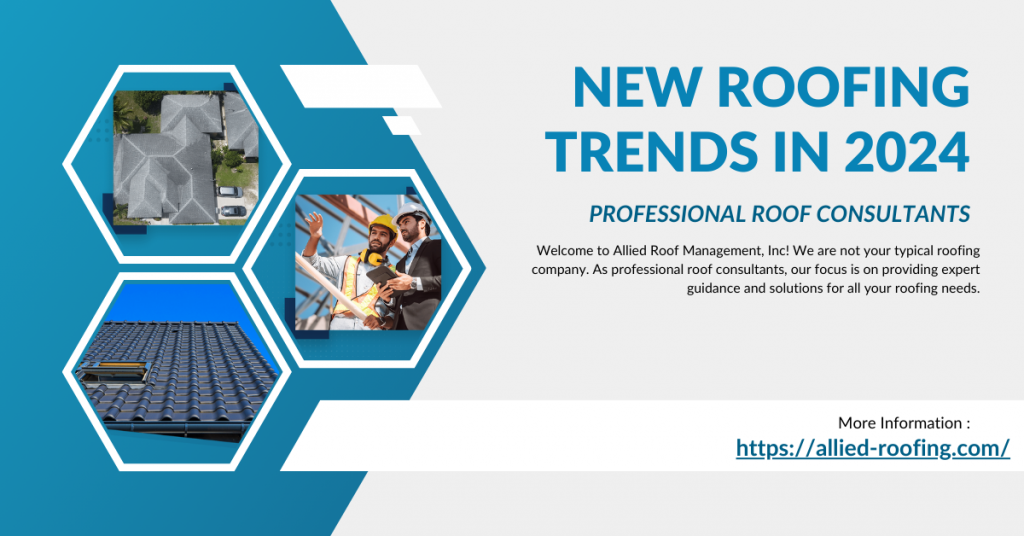Whether you’re a homeowner considering a roof renovation or a contractor searching for top-tier solutions for your clients, knowing the latest roofing trends is crucial. This year’s upcoming roofing styles deliver a harmonious blend of form and function, protecting homes and saving them money in the long run.
Additionally, sustainable and eco-friendly innovations continue to grow in popularity. From new insulation materials to energy-efficient roofs, these emerging roofing processes are redefining industry standards.

Modern Roofing Styles
New roofing trends deliver a harmonious blend of style, sustainability and modern technology. Homeowners are no longer just seeking protection from severe weather; they want their roofs to be a showcase of their personality and reflect the architectural design of their homes. Keeping up with these roofing trends will allow contractors to provide homeowners with the best options for their needs.
Asymmetrical designs and unconventional shapes are popular among homeowners looking to add a touch of uniqueness to their houses. These eye-catching styles can also be crafted from unconventional materials like reclaimed wood, offering an environmentally conscious option that repurposes old roofing materials instead of throwing them away. In addition, more homeowners are opting for a mix of different roofing materials, such as metal with traditional shingles or slate with solar tiles, to create visually dynamic exteriors.
For expert guidance on incorporating these innovative roofing options into your home design, consider leveraging the expertise of roofing consulting services. They can provide valuable insights and recommendations tailored to your specific needs and preferences, ensuring that your roofing project is both aesthetically pleasing and structurally sound.
Sustainability and durability are major considerations for many homeowners in 2024. As a result, there is an increased demand for roofs that are durable, energy-efficient, and long-lasting. Durable roofs are more resilient to harsh weather events and require less maintenance than other types of roofing materials.
Other sustainable options include cool roofs that reflect the sun rather than absorbing it, saving on energy costs; and green roofs that are covered with vegetation to reduce carbon footprints. Integrated solar roofs, which harness renewable energy for the household, are another rising trend in 2024.
Roofing material trends continue to change in 2024, with homeowners demanding a perfect blend of style and function. For this reason, contractors need to keep up with these innovations and offer their clients the best roofing solutions available.
Vibrant Colors
Aside from the protective role they play, roofs are increasingly being used as focal points for architectural design. This trend sees homeowners choosing unique roofing styles and eye-catching colors to complement the overall aesthetic of their homes. It’s an opportunity for contractors to show off their creativity and offer a range of aesthetic options for clients.
Homeowners are also embracing eco-friendly roofing materials to reduce their environmental footprint. Solar shingles that seamlessly blend with traditional roofing materials are gaining in popularity, as are cool roof coatings in reflective shades that lower energy costs. These advances in solar technology, coupled with growing consumer awareness, are creating a new standard for greener, more sustainable roofing.
Likewise, recycled roofing materials continue to grow in popularity as a way of decreasing the need for landfill space and encouraging circular economy principles. Whether they’re made from asphalt shingles, metal sheets, or even repurposed tiles, these roofing products are preferred for their durability, longevity, and low-upkeep demand.
In addition, mixed materials like wood and concrete or fiber cement and brick are becoming popular for their modern, eclectic appeal. This design feature offers a harmonious blend of timeless craftsmanship and groundbreaking progress, and it’s an excellent way for homeowners to achieve the look they want without breaking their budget.
Aside from the aforementioned trends, the year 2024 is shaping up to be an exciting one for the roofing industry. Innovative designs, cutting-edge color choices, and advanced smart technologies are just a few of the developments that are set to revolutionize the roofs that shelter us. By staying apprised of these emerging trends, homeowners and contractors alike can make well-informed decisions about which roofing options will best serve their needs in the years to come.
Smart Roofing Systems
With a growing emphasis on environmental responsibility, homeowners are prioritizing roofing options with a high level of sustainability. This includes materials that are eco-friendly, recyclable, and sourced from sustainable processes, as well as roofing designs that improve energy efficiency and reduce carbon footprints.
One popular trend is the use of modular roofing systems, which provide a faster and more efficient construction process. These systems involve pre-assembled roof components that can be easily installed on a home or business, eliminating the need for lengthy construction periods. Additionally, these systems are highly durable and can withstand extreme weather conditions.
Another trend that is gaining traction in 2024 is the integration of smart technology into roofing systems. These tech-savvy solutions offer real-time weather monitoring, automatic snow removal, and remote control through smartphone apps. They also help to increase safety, comfort, and energy efficiency.
For homeowners seeking to ensure the quality and longevity of their smart roofing installations, enlisting the assistance of quality assurance services is crucial. These services can conduct thorough inspections and assessments to verify that the smart technology is installed correctly and functioning optimally.
Additionally, incorporating smart roofing systems into a comprehensive roof maintenance management program can further enhance their performance and longevity. With a well-designed program in place, issues can be identified and addressed promptly, maximizing the benefits of smart technology while minimizing downtime and repair costs.
Moreover, warranty management services can provide peace of mind by overseeing warranty claims and ensuring that any potential issues are addressed promptly and effectively, further safeguarding the investment in smart roofing technology.
In addition, the use of solar panels is a rising trend in roofing. These systems allow homeowners to generate solar power on their while simultaneously reducing energy costs. This is a great way to minimize the impact of climate change while still enjoying the benefits of a comfortable, beautiful home.
Other trends in roofing include the use of unique materials and combinations of styles to create a distinctive aesthetic. This can be done by using metals with glass or combining traditional shingles with modern composites.
Additionally, many homeowners are opting for green roofs, which are made of vegetation that provides insulation and reduces energy consumption. Finally, drone technology is a rising roofing trend that allows contractors to efficiently assess and manage roofs by providing detailed images of hard-to-reach areas. This can help prevent costly leaks and repairs while improving overall roofing performance.
Energy-Efficient Roofs
Energy-efficient roofs use coatings and granules to reflect sunlight rather than absorb it, helping reduce home energy consumption and costs. These types of roofs can be installed on homes in any climate, including cold areas where it’s important to keep the home insulated and comfortable. They can also improve a home’s value and increase its durability.
One of the main reasons homeowners choose to install energy-efficient roofs is that they can save money on utility bills, especially during summer when homes can experience high air conditioning costs. Typically, these types of roofs come in lighter, more reflective colors that bounce the sun’s rays away from a house, keeping it cooler and decreasing the amount of work needed by an air conditioner to cool it.
Additionally, they can help reduce harmful greenhouse gases, which contribute to air pollution, by reducing the amount of energy used to heat and cool homes. Many homeowners who choose to install energy-efficient roofs may also qualify for tax credits or rebates from local, state, and federal governments.
Another new roofing trend that is expected to continue growing in popularity is green roofs. This type of roof uses vegetation to provide a range of benefits, including lowering building heating and cooling costs, improving biodiversity, and creating a natural space in urban environments. However, this type of roof requires extensive maintenance and careful planning, such as addressing issues with water drainage and maintaining plant health.
As homeowners are becoming increasingly concerned about climate change and rising energy costs, eco-friendly roofing options are surging in popularity. These types of roofs use materials that are durable and energy-efficient, including cool roof coatings in light, reflective colors that reduce heat absorption, ridge vents for improved air circulation, foam insulation panels for increased thermal efficiency, radiant barriers to prevent conductive heat transfer, and ventilation systems such as a sheathing vent (ASV). These features can help reduce homeowner energy costs and carbon emissions.
Green Roofs
Green roofs (also known as sky gardens, vegetative roofs, or living roofs) are becoming increasingly popular as a way to beautify buildings and create urban oases. They are also a great way to reduce stormwater runoff, control heat island effects, and moderate energy use. Additionally, they provide habitats for birds and insects and can help to improve air quality.
A green roof can vary in size from a shallow layer of ground cover to an entire park. While the initial installation can be more expensive than a regular building roof, green roofing pays for itself over time thanks to savings on water and energy costs. Green roofs can also be used to grow crops, which helps with food security.
Lastly, green roofs can add value to a building by increasing its aesthetics and creating jobs in the installation and maintenance of these spaces. Additionally, they can promote health and well-being by providing a calming space, improving air quality, and encouraging social interaction. One study found that office workers are 2.9% more productive when the view out their window includes greenery.
In 2024, green roofs continue to be a growing trend thanks to their many environmental and societal benefits. The CitiesAlive conference celebrates the growth of this industry by bringing together manufacturers, designers, researchers, and installers to showcase green roofing trends and innovations.
The roofing trends of 2024 emphasize sustainability, innovation, and personalized design. Homeowners are seeking eco-friendly materials, smart technology integration, and vibrant colors to create roofs that reflect their style and values. At Allied Roofing, Florida, we’re committed to providing cutting-edge solutions and expert guidance to meet these evolving needs. Contact us today to discover how we can help you achieve your roofing goals.


